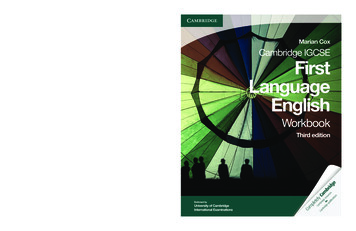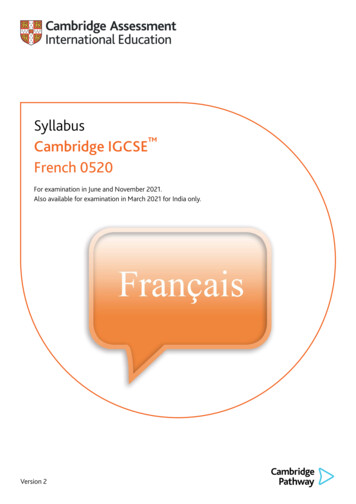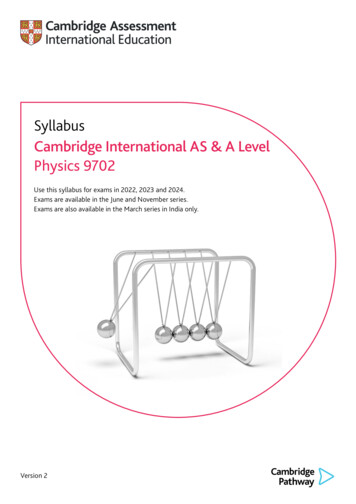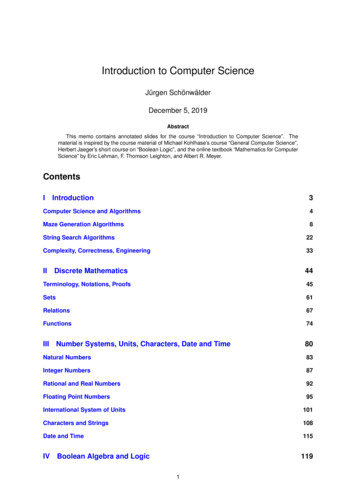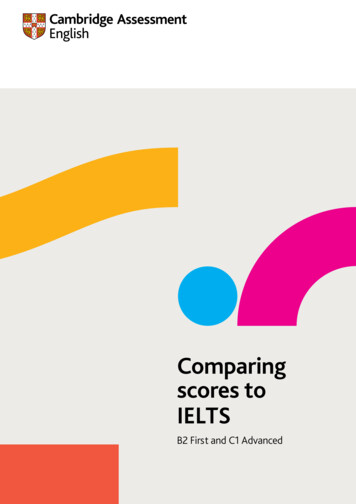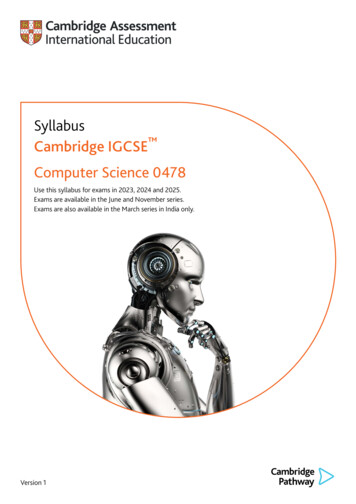
Transcription
SyllabusCambridge IGCSE Computer Science 0478Use this syllabus for exams in 2023, 2024 and 2025.Exams are available in the June and November series.Exams are also available in the March series in India only.Version 1
Why choose Cambridge International?Cambridge International prepares school students for life, helping them develop an informed curiosity and a lastingpassion for learning. We are part of the University of Cambridge.Our Cambridge Pathway gives students a clear path for educational success from age 5 to 19. Schools can shapethe curriculum around how they want students to learn – with a wide range of subjects and flexible ways to offerthem. It helps students discover new abilities and a wider world, and gives them the skills they need for life, so theycan achieve at school, university and work.Our programmes and qualifications set the global standard for international education. They are created by subjectexperts, rooted in academic rigour and reflect the latest educational research. They provide a strong platform forlearners to progress from one stage to the next, and are well supported by teaching and learning resources.Our mission is to provide educational benefit through provision of international programmes and qualifications forschool education and to be the world leader in this field. Together with schools, we develop Cambridge learnerswho are confident, responsible, reflective, innovative and engaged – equipped for success in the modern world.Every year, nearly a million Cambridge students from 10 000 schools in 160 countries prepare for their future withthe Cambridge Pathway.‘We think the Cambridge curriculum is superb preparation for university.’Christoph Guttentag, Dean of Undergraduate Admissions, Duke University, USAQuality managementCambridge International is committed to providing exceptional quality. In line with this commitment, ourquality management system for the provision of international qualifications and education programmesfor students aged 5 to 19 is independently certified as meeting the internationally recognised standard,ISO 9001:2015. Learn more at www.cambridgeinternational.org/ISO9001Copyright UCLES September 2020Cambridge Assessment International Education is part of the Cambridge Assessment Group. Cambridge Assessment is the brand name ofthe University of Cambridge Local Examinations Syndicate (UCLES), which itself is a department of the University of Cambridge.UCLES retains the copyright on all its publications. Registered centres are permitted to copy material from this booklet for their owninternal use. However, we cannot give permission to centres to photocopy any material that is acknowledged to a third party even forinternal use within a centre.
Contents1 Why choose this syllabus? . 22 Syllabus overview . 5Aims5Content overview6Assessment overview7Assessment objectives83 Subject content .9Computer systemsAlgorithms, programming and logic9234 Details of the assessment . 30Paper 1 – Computer Systems30Paper 2 – Algorithms, Programming and Logic30Mathematical requirements31Flowchart symbols31Logic gate symbols32Pseudocode33Command words475 What else you need to know . 48Before you start48Making entries49After the exam50How students and teachers can use the grades50Grade descriptions50Changes to this syllabus for 2023, 2024 and 202551Important: Changes to this syllabusFor information about changes to this syllabus for 2023, 2024 and 2025, go to page 51.
Cambridge IGCSE Computer Science 0478 syllabus for 2023, 2024 and 2025.1 Why choose this syllabus?Key benefitsCambridge IGCSE is the world’s most popular internationalqualification for 14 to 16 year olds, although it can be taken bystudents of other ages. It is tried, tested and trusted.Students can choose from 70 subjects in any combination – it istaught by over 4800 schools in over 150 countries.Our programmes balance a thorough knowledge and understandingof a subject and help to develop the skills learners need for theirnext steps in education or employment.CambridgelearnerCambridge IGCSE Computer Science provides an ideal foundationin computer science. Learners gain confidence in computationalthinking and programming, an appreciation of automated andemerging technologies and the benefits of their use. They develop an understanding of the main principles ofproblem-solving by creating computer-based solutions using algorithms and a high-level programming language.Learners also develop a range of technical skills including the ability to test effectively and to evaluate solutions.Our approach in Cambridge IGCSE Computer Science encourages learners to be:confident, interested in learning about computer science and using technical language to communicate theirknowledge and understandingresponsible, working systematically, safely and securely when using technologyreflective, learning from their experiences when creating programs and using technology; understanding howtechnology impacts societyinnovative, solving unfamiliar problems and designing computer programs creatively and independentlyengaged, keen to develop computer science skills and further their understanding of developments in the use oftechnology.‘The strength of Cambridge IGCSE qualifications is internationally recognised and has providedan international pathway for our students to continue their studies around the world.’Gary Tan, Head of Schools and CEO, Raffles International Group of Schools, Indonesia2www.cambridgeinternational.org/igcseBack to contents page
Cambridge IGCSE Computer Science 0478 syllabus for 2023, 2024 and 2025. Why choose this syllabus?International recognition and acceptanceOur expertise in curriculum, teaching and learning, and assessment is the basis for the recognition of ourprogrammes and qualifications around the world. The combination of knowledge and skills in Cambridge IGCSEComputer Science gives learners a solid foundation for further study. Candidates who achieve grades A* to C arewell prepared to follow a wide range of courses including Cambridge International AS & A Level Computer Science.Cambridge IGCSEs are accepted and valued by leading universities and employers around the world as evidence ofacademic achievement. Many universities require a combination of Cambridge International AS & A Levels andCambridge IGCSEs or equivalent to meet their entry requirements.UK NARIC, the national agency in the UK for the recognition and comparison of international qualifications andskills, has carried out an independent benchmarking study of Cambridge IGCSE and found it to be comparable tothe standard of the reformed GCSE in the UK. This means students can be confident that their Cambridge IGCSEqualifications are accepted as equivalent to UK GCSEs by leading universities worldwide.Learn more at idge IGCSE is one of the most sought-after and recognised qualifications in the world. Itis very popular in Egypt because it provides the perfect preparation for success at advanced levelprogrammes.’Managing Director of British School in Egypt BSEBack to contents pagewww.cambridgeinternational.org/igcse3
Cambridge IGCSE Computer Science 0478 syllabus for 2023, 2024 and 2025. Why choose this syllabus?Supporting teachersWe provide a wide range of resources, detailed guidance and innovative training and professional development sothat you can give your students the best possible preparation for Cambridge IGCSE. To find out which resources areavailable for each syllabus go to our School Support Hub.The School Support Hub is our secure online site for Cambridge teachers where you can find the resources you needto deliver our programmes. You can also keep up to date with your subject and the global Cambridge communitythrough our online discussion forums.Find out more at www.cambridgeinternational.org/supportPlanning and preparationTeaching and assessment Next step guides Endorsed resources Schemes of work Online forums Specimen papers Support for coursework and speaking tests Syllabuses Teacher guidesLearning and revisionSupportfor CambridgeIGCSE Example candidate responsesResults Candidate Results Service Learner guides Principal examiner reports for teachers Past papers and mark schemes Results Analysis Specimen paper answersSign up for email notifications about changes to syllabuses, including new and revised products and services ofessional developmentWe support teachers through: Introductory Training – face-to-face or online Extension Training – face-to-face or online Enrichment Professional Development – face-to-face or onlineFind out more at www.cambridgeinternational.org/events Cambridge Professional Development QualificationsFind out more at www.cambridgeinternational.org/profdevSupporting exams officersWe provide comprehensive support and guidance for all Cambridge exams officers. Find out more ridgeinternational.org/igcseBack to contents page
Cambridge IGCSE Computer Science 0478 syllabus for 2023, 2024 and 2025.2 Syllabus overviewAimsThe aims describe the purposes of a course based on this syllabus.The aims are to enable students to develop: computational thinking skills an understanding of the main principles of solving problems using computers the skills necessary to solve computer-based problems using a high-level programming language an understanding of the component parts of computer systems and how they interrelate an understanding of the internet as a means of communication and its associated risks an understanding of the development and use of automated and emerging technologies.Cambridge Assessment International Education is an education organisation and politically neutral.The contents of this syllabus, examination papers and associated materials do not endorse any politicalview. We endeavour to treat all aspects of the exam process neutrally.Back to contents pagewww.cambridgeinternational.org/igcse5
Cambridge IGCSE Computer Science 0478 syllabus for 2023, 2024 and 2025. Syllabus overviewContent overviewCandidates study the following topics:Computer systems1Data representation2Data transmission3Hardware4Software5The internet and its uses6Automated and emerging technologiesAlgorithms, programming and logic7Algorithm design and problem-solving8Programming9Databases10 Boolean logic6www.cambridgeinternational.org/igcseBack to contents page
Cambridge IGCSE Computer Science 0478 syllabus for 2023, 2024 and 2025. Syllabus overviewAssessment overviewAll candidates take two components. Candidates will be eligible for grades A* to G.All candidates take:Paper 1Computer Systemsand:1 hour 45 minutes50%Paper 21 hours 45 minutesAlgorithms, Programming and Logic50%75 marks75 marksShort-answer and structured questionsShort-answer and structured questions and ascenario-based questionQuestions will be based on Topics 1–6 of thesubject contentAll questions are compulsoryNo calculators are permittedExternally assessedQuestions will be based on Topics 7–10 of thesubject contentAll questions are compulsoryNo calculators are permittedExternally assessedInformation on availability is in the Before you start section.Back to contents pagewww.cambridgeinternational.org/igcse7
Cambridge IGCSE Computer Science 0478 syllabus for 2023, 2024 and 2025. Syllabus overviewAssessment objectivesThe assessment objectives (AOs) are:AO1Demonstrate knowledge and understanding of the principles and concepts of computer science.AO2Apply knowledge and understanding of the principles and concepts of computer science to a given context,including the analysis and design of computational or programming problems.AO3Provide solutions to problems by: evaluating computer systems making reasoned judgements presenting conclusions.Weighting for assessment objectivesThe approximate weightings allocated to each of the assessment objectives (AOs) are summarised below.Assessment objectives as a percentage of the qualificationAssessment objectiveWeighting in IGCSE %AO140AO240AO320Total100Assessment objectives as a percentage of each componentAssessment objective8Weighting in components %Paper 1Paper rnational.org/igcseBack to contents page
Cambridge IGCSE Computer Science 0478 syllabus for 2023, 2024 and 2025.3 Subject contentThis syllabus gives you the flexibility to design a course that will interest, challenge and engage your learners.Where appropriate you are responsible for selecting resources and examples to support your learners’ study. Theseshould be appropriate for the learners’ age, cultural background and learning context as well as complying withyour school policies and local legal requirements.Computer Science is a practical subject and a range of practical exercises must be integral to the teaching of thisqualification. It is important that learners develop their computational thinking skills by doing practical problemsolving and programming using appropriate resources. It is also expected that learners have the opportunity in classto write their own programs, as well as executing (running), testing and debugging them.Any equipment and facilities should be adequate for learners to be able to satisfy the requirements of the syllabus.The hardware facilities needed will depend on the number of learners but must be sufficient for all learners to haveenough time to practise their programming skills. Learners also need to have access to a system with direct-accessfile capability on backing store and hardcopy facilities.Computer systems1Data representation1.1Number systemsCandidates should be able to:Notes and guidance1 Any form of data needs to be converted to binaryto be processed by a computer Data is processed using logic gates and stored inregisters Denary is a base 10 system Binary is a base 2 system Hexadecimal is a base 16 system Values used will be integers only Conversions in both directions, e.g. denary tobinary or binary to denary(iii) positive hexadecimal and positive binary Maximum binary number length of 16-bitUnderstand how and why hexadecimal is used asa beneficial method of data representation Areas within computer science that hexadecimalis used should be identified Hexadecimal is easier for humans to understandthan binary, as it is a shorter representation ofthe binary An overflow error will occur if the value is greaterthan 255 in an 8-bit register A computer or a device has a predefined limitthat it can represent or store, for example 16-bit An overflow error occurs when a value outsidethis limit should be returned2Understand how and why computers use binaryto represent all forms of data(a) Understand the denary, binary andhexadecimal number systems(b) Convert between(i) positive denary and positive binary(ii) positive denary and positive hexadecimal34(a) Add two positive 8-bit binary integers(b) Understand the concept of overflow and whyit occurs in binary additionBack to contents pagewww.cambridgeinternational.org/igcse9
Cambridge IGCSE Computer Science 0478 syllabus for 2023, 2024 and 2025. Subject content1.1Number systems continuedCandidates should be able to:Notes and guidance5 Perform logical left shifts Perform logical right shifts Perform multiple shifts Bits shifted from the end of the register are lostand zeros are shifted in at the opposite end of theregister The positive binary integer is multiplied ordivided according to the shift performed The most significant bit(s) or least significantbit(s) are lost Convert a positive binary or denary integer to atwo’s complement 8-bit integer and vice versa Convert a negative binary or denary integer to atwo’s complement 8-bit integer and vice versa6Perform a logical binary shift on a positive 8-bitbinary integer and understand the effect this hason the positive binary integerUse two’s complement to represent positive andnegative 8-bit binary integers1.2 Text, sound and imagesCandidates should be able to:Notes and guidance1 Text is converted to binary to be processed by acomputer Unicode allows for a greater range of charactersand symbols than ASCII, including differentlanguages and emojis Unicode requires more bits per character thanASCII A sound wave is sampled for sound to beconverted to binary, which is processed by acomputer The sample rate is the number of samples takenin a second The sample resolution is the number of bits persample The accuracy of the recording and the file sizeincreases as the sample rate and resolutionincrease210Understand how and why a computer representstext and the use of character sets, includingAmerican standard code for informationinterchange (ASCII) and UnicodeUnderstand how and why a computer representssound, including the effects of the sample rateand sample resolutionwww.cambridgeinternational.org/igcseBack to contents page
Cambridge IGCSE Computer Science 0478 syllabus for 2023, 2024 and 2025. Subject content1.2 Text, sound and images continuedCandidates should be able to:Notes and guidance3 An image is a series of pixels that are convertedto binary, which is processed by a computer The resolution is the number of pixels in theimage The colour depth is the number of bits used torepresent each colour The file size and quality of the image increases asthe resolution and colour depth increaseUnderstand how and why a computer representsan image, including the effects of the resolutionand colour depth1.3 Data storage and compressionCandidates should be able to:Notes and guidance1 Understand how data storage is measured 23Calculate the file size of an image file and asound file, using information givenUnderstand the purpose of and need for datacompressionBack to contents pageIncluding:–bit–nibble–byte–kibibyte (KiB)–mebibyte (MiB)–gibibyte (GiB)–tebibyte (TiB)–pebibyte (PiB)–exbibyte (EiB)The amount of the previous denominationpresent in the data storage size, e.g.:–8 bits in a byte–1024 mebibytes in a gibibyte Answers must be given in the units specified inthe question Information given may include:–image resolution and colour depth–sound sample rate, resolution and length oftrack Compression exists to reduce the size of the file The impact of this is, e.g.:–less bandwidth required–less storage space required–shorter transmission timewww.cambridgeinternational.org/igcse11
Cambridge IGCSE Computer Science 0478 syllabus for 2023, 2024 and 2025. Subject content1.3 Data storage and compression continuedCandidates should be able to:Notes and guidance4 Lossless compression reduces the file sizewithout permanent loss of data, e.g. run lengthencoding (RLE) Lossy compression reduces the file size bypermanently removing data, e.g. reducingresolution or colour depth, reducing sample rateor resolution2Understand how files are compressed using lossyand lossless compression methodsData transmission2.1 Types and methods of data transmissionCandidates should be able to:1Notes and guidance(a) Understand that data is broken down intopackets to be transmitted(b) Describe the structure of a packet (c) Describe the process of packet switching2312(a) Describe how data is transmitted from onedevice to another using different methods ofdata transmissionA packet of data in a unit of data contains a–packet header–payload–trailerThe packet header includes the:–destination address–packet number–originator’s address Data is broken down into packets Each packet could take a different route A router controls the route a packet takes Packets may arrive out of order Once the last packet has arrived, packets arereordered plex–full-duplex(b) Explain the suitability of each method of datatransmission, for a given scenario Including the advantages and disadvantages ofeach methodUnderstand the universal serial bus (USB)interface and explain how it is used to transmitdata Including the benefits and drawbacks of ck to contents page
Cambridge IGCSE Computer Science 0478 syllabus for 2023, 2024 and 2025. Subject content2.2 Methods of error detectionCandidates should be able to:Notes and guidance1Understand the need to check for errors afterdata transmission and how these errors can occur Errors can occur during data transmission due tointerference, e.g. data loss, data gain and datachange2Describe the processes involved in each of thefollowing error detection methods for detectingerrors in data after transmission: parity check(odd and even), checksum and echo check Including parity byte and parity block check3Describe how a check digit is used to detecterrors in data entry and identify examples ofwhen a check digit is used, including internationalstandard book numbers (ISBN) and bar codes4Describe how an automatic repeat query (ARQ)can be used to establish that data is receivedwithout error Including the use of:–positive/negative acknowledgements–timeout2.3 EncryptionCandidates should be able to:1Understand the need for and purpose ofencryption when transmitting data2Understand how data is encrypted usingsymmetric and asymmetric encryptionBack to contents pageNotes and guidance Asymmetric encryption includes the use of publicand private keyswww.cambridgeinternational.org/igcse13
Cambridge IGCSE Computer Science 0478 syllabus for 2023, 2024 and 2025. Subject content3Hardware3.1 Computer architectureCandidates should be able to:Notes and guidance1(a) Understand the role of the central processingunit (CPU) in a computer The CPU processes instructions and data that areinput into the computer so that the result can beoutput(b) Understand what is meant by amicroprocessor A microprocessor is a type of integrated circuiton a single chip(a) Understand the purpose of the componentsin a CPU, in a computer that has aVon Neumann architecture Including:2(b) Describe the process of thefetch–decode–execute cycle including therole of each component in the process14–units: arithmetic logic unit (ALU) and controlunit (CU)–registers: program counter (PC), memoryaddress register (MAR), memory data register(MDR), current instruction register (CIR) andaccumulator (ACC)–buses: address bus, data bus and control bus How instructions and data are fetched fromrandom access memory (RAM) into the CPU,how they are processed using each componentand how they are then executed Storing data and addresses into specific registers Using buses to transmit data, addresses andsignals Using units to fetch, decode and execute dataand instructions3Understand what is meant by a core, cache andclock in a CPU and explain how they can affectthe performance of a CPU The number of cores, size of the cache and speedof the clock can affect the performance of a CPU4Understand the purpose and use of an instructionset for a CPU An instruction set is a list of all the commandsthat can be processed by a CPU and thecommands are machine code5Describe the purpose and characteristics of anembedded system and identify devices in whichthey are commonly used An embedded system is used to perform adedicated function, e.g. domestic appliances,cars, security systems, lighting systems orvending machines. This is different to a generalpurpose computer that is used to perform manydifferent functions, e.g. a personal computer (PC)or a laptopwww.cambridgeinternational.org/igcseBack to contents page
Cambridge IGCSE Computer Science 0478 syllabus for 2023, 2024 and 2025. Subject content3.2 Input and output devicesCandidates should be able to:Notes and guidance1 23Understand what is meant by an input device andwhy it is requiredUnderstand what is meant by an output deviceand why it is required(a) Understand what is meant by a sensor andthe purposes of sensors Including:–barcode scanner–digital camera–keyboard–microphone–optical mouse–QR code scanner–touch screen (resistive, capacitive andinfra-red)–two-dimensional (2D) and three-dimensional(3D) scannersIncluding:–actuator–digital light processing (DLP) projector–inkjet printer–laser printer–light emitting diode (LED) screen–liquid crystal display (LCD) projector–liquid crystal display (LCD) screen–speaker–3D printerLimited dity–infra-red–level–light–magnetic perature(b) Identify the type of data captured by eachsensor and understand when each sensorwould be used, including selecting the mostsuitable sensor for a given contextBack to contents pagewww.cambridgeinternational.org/igcse15
Cambridge IGCSE Computer Science 0478 syllabus for 2023, 2024 and 2025. Subject content3.3 Data storageCandidates should be able to:Notes and guidance1 Primary storage is directly accessed by the CPU Including the role of:–random access memory (RAM)–read only memory (ROM) Including why a computer needs both RAM andROM, and the difference between them2Understand what is meant by secondary storage Secondary storage is not directly accessed bythe CPU and is necessary for more permanentstorage of data3Describe the operation of magnetic, optical andsolid-state (flash memory) storage and giveexamples of each Magnetic storage uses platters which are dividedinto tracks and sectors. Data is read and writtenusing electromagnets Optical storage uses lasers to create and read pitsand lands Solid-state (flash memory) uses NAND or NORtechnology. Transistors are used as control gatesand floating gates Pages of data are transferred between RAM andvirtual memory when needed Cloud storage can be accessed remotely incomparison to storing data locally Physical servers and storage are needed to storedata in cloud storage4Describe what is meant by virtual memory, howit is created and used and why it is necessary5Understand what is meant by cloud storage616Understand what is meant by primary storageExplain the advantages and disadvantages ofstoring data on the cloud in comparison tostoring it locallywww.cambridgeinternational.org/igcseBack to contents page
Cambridge IGCSE Computer Science 0478 syllabus for 2023, 2024 and 2025. Subject content3.4 Network hardwareCandidates should be able to:1Understand that a computer needs a networkinterface card (NIC) to access a network2Understand what is meant by and the purpose ofa media access control (MAC) address, includingits structure344Notes and guidance A network interface card is given a MAC addressat the point of manufacture MAC addresses are usually written ashexadecimal MAC addresses are created using themanufacturer code and the serial code(a) Understand what is meant by and thepurpose of an internet protocol (IP) address An IP address is allocated by the network andthey can be static or dynamic(b) Understand that there are different types ofIP address Including the characteristics of and differencesbetween IPv4 and IPv6Describe the role of a router in a network A router sends data to a specific destination on anetwork A router can assign IP addresses A router can connect a local network to theinternetSoftware4.1 Types of software and interruptsCandidates should be able to:Notes and guidance1 System software provides the services that thecomputer requires, including operating systemand utility software Application software provides the services thatthe user requires Including:2Describe the difference between system softwareand application software and provide examplesof eachDescribe the role and basic functions of anoperating systemBack to contents page–managing files–handling interrupts–providing an interface–managing peripherals and drivers–managing memory–managing multitasking–providing a platform for running applications–providing system security–managing user accountswww.cambridgeinternational.org/igcse17
Cambridge IGCSE Computer Science 0478 syllabus for 2023, 2024 and 2025. Subject content4.1 Types of software and interrupts continuedCandidates should be able to:Notes and guidance3Understand how hardware, firmware and anoperating system are required to run applicationssoftware Applications are run on the operating system The operating system is run on the firmware The bootloader (firmware) is run on the hardwareDescribe the role and operation of interrupts Including:4–how an interrupt is generated–how it is handled using an interrupt serviceroutine–what happens as a result of the interrupts Software interrupts include division by zero andtwo processes trying to access the same memorylocation Hardware interrupts include pressing a key on thekeyboard and moving the mouse4.2 Types of programming language, translators and integrated development environments (IDEs)18Candidates should be able to:Notes and guidance1 Explain what is meant by a high-level languageand a low-level language, including theadvantages and disadvantages of each2Understand that assembly language is a formof low-level language that uses mnemonics,and that an assembler is needed to translate anassembly language program into machine code3Describe the operation of a compiler and aninterpreter, including how high-level language istranslated by each and how errors are ages and disadvantages include:–ease of reading and writing code,e.g. low-level is hard to read–ease of debugging code–machine independence–direct manipulation of hardware A compiler translates the whole code at oncebefore executing it, producing an executa
Key benefits Cambridge IGCSE is the world’s most popular international . Algorithms, programming and logic 7 Algorithm design and problem-solving 8 Programming 9 Databases . Short-answer and structur

